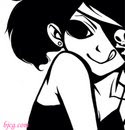
Blythe (pronounced [blaɪθ]) is a doll created in 1972 by designer Allison Katzman with the now-defunct U.S. toy company Kenner. Reportedly, she was modelled after drawings by Margaret Keane, similarly to many other dolls of the '60s and '70s. Her most distinctive and notable feature were eyes that changed color with the pull of a string attached to the back of her head. Due to a lack of interest, Blythe dolls were only sold for one year in the U.S. (produced in Hong Kong), during 1972.
History
Blythe was created in 1972 by designer Allison Katzman and marketed for one year in the USA by toy company Kenner. The doll would only become popular some 30 years later.
In 1997, New York TV and video producer Gina Garan was given a 1972 Kenner Blythe by a friend and began using it to practice her photographic skills. She began taking her Blythe everywhere with her and took hundreds of photos. In 1999, she was introduced to CWC's Junko Wong by artist and illustrator, Jeffrey Fulvimari which brought Blythe to the attention of Parco and toy executives. In 2002, Gina published her first book of Blythe photography with Chronicle Books, This is Blythe. Later that year, Hasbro (the Trademark and License owner) gave Takara of Japan a license to produce the New Edition of Blythe (NEO Blythe). Blythe was used in a television advertising campaign by the Parco department store in Japan and was an instant hit. Success in Japan led Hasbro to issue a license to Ashton Drake Galleries (ADG)to produce Blythe exclusively in the U.S., where the doll become a niche product in a marginal market, selling largely to adults.
Blythe was created in 1972 by designer Allison Katzman and marketed for one year in the USA by toy company Kenner. The doll would only become popular some 30 years later.
In 1997, New York TV and video producer Gina Garan was given a 1972 Kenner Blythe by a friend and began using it to practice her photographic skills. She began taking her Blythe everywhere with her and took hundreds of photos. In 1999, she was introduced to CWC's Junko Wong by artist and illustrator, Jeffrey Fulvimari which brought Blythe to the attention of Parco and toy executives. In 2002, Gina published her first book of Blythe photography with Chronicle Books, This is Blythe. Later that year, Hasbro (the Trademark and License owner) gave Takara of Japan a license to produce the New Edition of Blythe (NEO Blythe). Blythe was used in a television advertising campaign by the Parco department store in Japan and was an instant hit. Success in Japan led Hasbro to issue a license to Ashton Drake Galleries (ADG)to produce Blythe exclusively in the U.S., where the doll become a niche product in a marginal market, selling largely to adults.
In 2003 Blythe was the subject in a segment on the popular VH1 special, I Love the 70s, where she was said to look like either "Barbie with elephantiasis" or "Christina Ricci" among other things.
In 2004, the Ashton-Drake Galleries began to produce their own Blythe replica dolls in the United States.
A vibrant Blythe subculture flourishes on the Internet, predominantly in forums and user groups. There is a large network of hobbyists who customise the doll for resale, people who create unique clothing and shoes, as well as accessories specifically for Blythe.
Dolls
There are two types of Blythe dolls: the 28cm (1/6th scale) "NEO" and the 11.2 cm "Petit Blythe." Only NEO Blythes have colour-changing eyes, which include the colours blue, green, orange, and pink (except for cases with limited-edition dolls). Newer releases of the Petit Blythe dolls have moveable eyelids and bendable bodies.
A smaller Kubrick version of Blythe also exists.
The measurements of Blythe: 4.17-2.76-3.89 (in inches) or 106-70-99 (in mm). The measurements of Petit Blythe: 1.77-1.18-16.5 (in inches) or 45-30-42 (in mm).
Blythe dolls range in price (at release date) from USD$60 (ADG versions) upwards of USD$300 (limited edition NEOs). Older dolls are sought after in the collectors market, and can sell for as high as several thousand dollars for a Kenner to a thousand dollars or more for the first edition NEO.
There are two types of Blythe dolls: the 28cm (1/6th scale) "NEO" and the 11.2 cm "Petit Blythe." Only NEO Blythes have colour-changing eyes, which include the colours blue, green, orange, and pink (except for cases with limited-edition dolls). Newer releases of the Petit Blythe dolls have moveable eyelids and bendable bodies.
A smaller Kubrick version of Blythe also exists.
The measurements of Blythe: 4.17-2.76-3.89 (in inches) or 106-70-99 (in mm). The measurements of Petit Blythe: 1.77-1.18-16.5 (in inches) or 45-30-42 (in mm).
Blythe dolls range in price (at release date) from USD$60 (ADG versions) upwards of USD$300 (limited edition NEOs). Older dolls are sought after in the collectors market, and can sell for as high as several thousand dollars for a Kenner to a thousand dollars or more for the first edition NEO.
Blythe bodies (neo)
The bodies of Blythe varies depending on the time of the release. Earlier releases uses the BL (basic Licca) body, which has some disadvantages. For example, the legs do not bend as well as the later releases.
The bodies of Blythe varies depending on the time of the release. Earlier releases uses the BL (basic Licca) body, which has some disadvantages. For example, the legs do not bend as well as the later releases.
BL: June 2001-March 2002. Licca body is used, eyes glance further to the side, matte face for some models. Some also have boggled eyes so the upper lid does not show on their eyes. Hair is also generally thinner.
EBL (Excellent): June 2002-October 2003. New body is introduced. Unlike the earlier Licca body, EBL bodies do not have bendable arms, though their legs have three "clicks" at the knee. Faces are shinier.
SBL (Superior): February 2004-present. New face mould and new sparkly eye chips. The new head of the doll is fashioned from a complete piece of plastic.
RBL (Radiance): December 2006-present. New face mould to look more Kenner-like, including a slightly wider eyes.
Ashton Drake Galleries also produced a replica of the 4 originals Kenners, with similar boxes and the same outfits and hair colours. They tried to make the face mould more similar to the original Kenner. Noticeable differences are the skin-tone has a slight green tint, eye holes are wider, and the colours of the make-up quite vibrant.
Blythe designs
Takara frequently releases new versions of Blythe. They are usually first shown by a vector-styled design with variations before it is confirmed.
There have been over a 100 releases of Takara Blythe in the Neo size from 2001-2008, and around 80 different Petite Takara Blythe releases. Several Blythe related books have been released, the most significant one being This is Blythe.
Takara frequently releases new versions of Blythe. They are usually first shown by a vector-styled design with variations before it is confirmed.
There have been over a 100 releases of Takara Blythe in the Neo size from 2001-2008, and around 80 different Petite Takara Blythe releases. Several Blythe related books have been released, the most significant one being This is Blythe.
















.jpg)











No comments:
Post a Comment